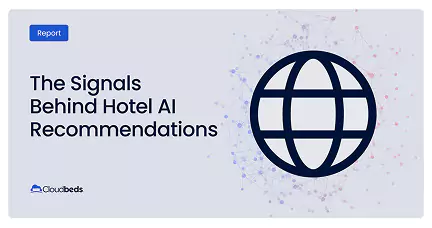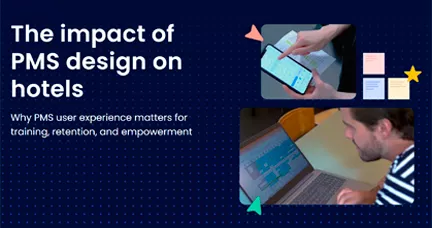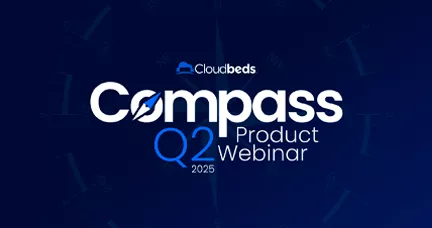Guests can’t book a room they can’t find, and in today’s market, visibility is everything. If you’re still logging into multiple extranets to update rates and availability, you’re wasting precious hours and leaving money on the table.
A channel manager puts your distribution on autopilot, syncing your inventory across every booking site in real time so you can focus on filling rooms, not fighting spreadsheets.
In this guide, we’ll break down what a channel manager does, how it works, and what to look for so you can choose the right one to maximize reach and revenue.
What is a channel manager?
A channel manager is software that keeps your room availability, rates, and restrictions in sync across every online booking channel you sell on automatically and in real time. Change your price in one place, and it updates everywhere, instantly.
Instead of logging in to Booking.com, Expedia, Airbnb, and every other site one by one, you manage everything from a single dashboard. No manual updates, no missed changes, no overbookings, just one source of truth for your inventory.
Without channel management automation, properties must log in to the extranet of each online distribution site they’re using and make the changes manually. This limits the number of online channels they use. After all, there’s only so much time in the day to manually manage individual extranets. And even then, manually managed distribution is risky: any delays in updating rates and availability on a channel’s extranet could mean selling a room that isn’t available or selling at a lower rate, which can lead to overbooking and sub-optimal yield management.
Channel management is the process of actively managing the distribution of rates and availability on multiple online distribution sites. These sites may vary to include online travel agencies (OTAs) such as Booking.com, Expedia, Tripadvisor, or Agoda; travel metasearch engines such as Google, Kayak, and Trivago; GDSs such as Amadeus and Sabre; bed banks such as Hotelbeds, or online marketplaces such as Airbnb, Vrbo (former HomeAway), etc.
How does a channel manager work?
At its core, a channel manager connects your property management system (PMS) or central reservation system (CRS) to all your online sales channels—OTAs, metasearch, GDS, even your own booking engine.
When you update a nightly rate, close a room, or adjust restrictions in your main dashboard, the channel manager pushes those changes to every connected channel instantly. And when a booking (or cancellation) comes in from any channel, it automatically updates your availability everywhere else, so there’s never a risk of selling the same room twice.
In more technical terms, a channel manager uses two-way sync via XML to connect to each individual channel’s extranet. It then pushes ARI updates to that channel and, for two-way sync, it imports reservations/cancellations into your channel manager, PMS, and/or CRS dashboard. It’s an automatic, seamless two-way flow that keeps everything synced and virtually eliminates the risk of overbookings or mistakes like inaccurate rates.
In the case of one-way sync, reservations or cancellations will not be imported. With advanced channel management connections, the update is fast. To illustrate, the average new Expedia booking is delivered to the Cloudbeds channel manager within seconds.
Channel managers prevent inaccurate rates or double bookings by using what’s known as “pooled inventory model.” This functionality aggregates inventory into a single place so that all bookings are pulled from one “pool” that’s based on real-time availability updates to/from the property management system. By putting all inventory into a single place, hotel rooms are never overbooked because the same room can’t be booked by two different websites.
Channel managers do 3 more key tasks: inventory allotment, inventory mapping, and PMS updates.
- Allotment: A sophisticated channel management strategy is based on a diverse mix of high-performing channels. It’s a channel manager’s job to dynamically allocate inventory according to your objectives.
- Channel mapping: The software maps room types to each channel’s formatting requirements so that rooms display consistently across all online sales channels while also syncing seamlessly back into the PMS. There are no duplications or manual reconciliations required!
- PMS updates: Your channel manager connects directly to your hotel property management system, acting as the real-time shepherd of rate and availability data between your PMS and whichever booking websites you sell on. Each new reservation is delivered right into the PMS without any manual intervention.
Why is it important to use a channel manager?
While it’s possible to manage your inventory by connecting to each channel’s extranet and manually updating availability, rates, and inventory, it’s not very efficient, and it’s also prone to human errors. With a good channel manager, you can save time, get more bookings, and distribute room inventory easily.
The following are the top reasons to use a channel management system:
1. Market reach
A channel manager puts your property in front of more travelers than ever before. Since it’s relatively simple to connect to a new booking site, there’s a low investment of time and resources to push your inventory. This means that properties of all sizes can now access new, global regions and segments (corporate/leisure/group) that were difficult to access via manual channel management.
Multiple booking sources mean more visibility – and, ultimately, more bookings. This leads to higher occupancy, especially in times of low demand when it’s needed the most.
2. Higher ROI
Channel managers create new ways to sell existing inventory, resulting in a higher return on your investment in both your sales and marketing efforts. With pooled inventory, advanced rates with discounts or non-refundable rates, and upsell integrations, hotels optimize revenue management with smart pricing strategies.
Another way to sell a room is by using shared inventory, which is when you sell the same room under multiple room types. An example of this would be selling a room as either a dorm room or a private single room. Of course, the risks here are selling the same room twice. By listing shared inventory via a hotel channel manager, the system automatically ensures that any linked room will never be sold twice.
Real-time updates also improve search performance on OTAs, which rank properties higher if they have real-time updates of ARI. When content is accurate and updated, properties enjoy better positioning in search results, leading to higher ROI.
3. Optimal distribution
Since each OTA has its own cost and commission structure, a profitable distribution strategy requires careful consideration of which sales channels to use, how much inventory to allocate to each, and how to adapt that channel mix to achieve your objectives.
By using different channels like OTAs, metasearch websites, B2B wholesale or niche accommodation booking sites, you make sure your property is visible to the right type of guest. For example, property owners can shift inventory from big-name OTAs (like Booking.com and Expedia) to more niche OTAs that sell to specific travelers, such as boutique-only OTAs (Mr and Mrs Smith), last-minute bookings (HotelTonight), or even alternative outdoor lodging (GlampingHub).
4. Money and time savings
It takes a while to get familiar with each channel’s interface. Without any tool, it’s a time-consuming job to log into each channel’s extranet and update ARI several times per day. That time cost correlates closely to the financial cost of paying someone on staff to manually manage distribution.
Software also makes the pursuit of profitable distribution much simpler. With a single view, hoteliers have more granular control of distribution costs. This saves money by emphasizing lower-cost channels first and then moving inventory to the higher-cost ones to fill gaps in demand.
What to consider when choosing your software
Best-in-class channel managers are built to connect to hundreds of booking sites reliably and accurately, with near-perfect uptime. Here are key features to consider.
Connectivity
The most advanced channel management platforms today offer advanced API connections with two-way synchronization. Updates are made in real-time, and it’s all cloud-based, which eliminates the need for on-property technology and allows for greater flexibility and speed. The system is very powerful as it supports up to millions of bookings per day.
Channel partners
Choose a provider that connects to various booking sites and global markets so you can reach travelers from around the world. Options should include big-name OTAs, niche OTAs, metasearch engine websites, and GDS (global distribution systems). Check if the provider charges additional fees or commissions for connecting various channels.
Functionalities
Look for simplicity, a product that’s user-friendly, intuitive, and meant for self-service. It’s about adding a tool you’ll be using consistently. Other useful advanced options include payment processing, multi-currency support, reporting, multiple users and user roles, etc.
PMS & booking engine integration
Your channel manager should also integrate with your other tools, especially your property management software and booking engine. This way, all of your hospitality management systems will be in sync, and you can log into one system to manage them all, saving countless hours and avoiding manual errors.
Channel managers and property management systems
Your property management system (PMS) is your hotel’s control center—it manages reservations, check-ins and check-outs, rates, payments, guest communication, reporting, and more. A channel manager is your distribution engine—pushing that availability, pricing, and restriction data to all your booking channels and pulling reservations back into your PMS.
The way these two systems work together can make or break your efficiency. Today, there are three main setups:
1. Platform approach
. Platforms like Cloudbeds offer a PMS and channel manager into one solution, giving you:
-
One login, one dashboard – Manage operations and distribution from a single place, with all reservation, guest, and pricing data in sync.
-
Real-time updates – When you adjust rates or close a room, it updates everywhere instantly, preventing mismatched prices or accidental overbookings.
-
Full feature alignment – Sync amenities, photos, rate plans, and promotions across all channels without managing separate integrations.
-
Faster updates from OTAs – One connectivity team applies and tests API changes right in your main system.
-
More built-in tools – Systems like Cloudbeds also include a commission-free booking engine, payment processing, marketing tools, and more.
-
One support team – One partner to call, one agreement to manage.
2. Separate PMS & integrated channel manager
Some properties use a PMS and a channel manager from different providers, connected via an integration. This setup can still work well if:
-
The integration is strong – Check that your PMS and channel manager pass all data in real time without delays.
-
You can manage two vendors – You’ll have two support teams and two contracts, so coordination is key when issues arise.
-
You double-check compatibility – Any OTA updates must be applied on both sides of the integration.
Cloudbeds also supports this setup through integration partners.
3. Channel manager without a PMS
While possible, running only a channel manager usually means handling key operations manually—like guest check-in/out, housekeeping coordination, or invoicing.
You’ll need to decide:
-
How will you track and update reservations internally?
-
Where will guest data and payment info live?
-
How will you generate invoices and reports?
-
How will you manage communication with guests before, during, and after their stay?
This approach can work for very small properties, but most hotels quickly outgrow it as daily tasks multiply.
What to consider when choosing a provider
Here are the must-haves and questions to ask when selecting the best hotel channel manager for your hotel.
Pricing Model. Is the provider working on a per-booking commission basis? Does a flat fee/subscription model apply? Are there mandatory setup fees? Each technology must serve a clear purpose with a compelling return on investment. Commission-based or channel-based pricing gets complicated and costly.
Onboarding and ongoing support. Before deciding on a provider, you’ll want to know what it takes to get started. How long is the onboarding process? Is there guidance for setting up your account? What kind of support do they offer? How robust is the knowledge base for self-service learning and troubleshooting?
Industry Recognition. Major OTAs also run programs for software partners, and each year they recognize Preferred Partnerships that fulfill the highest technical benchmarks of connection. Also, look for companies that offer a free trial or free use of a demo account so you can test the tech out before you commit.
Safety and Security Compliance: When it comes to systems that handle sensitive data, like your rates and guest information, you’ll want to ensure your data is secure. Inquire about compliance: PCI DSS, SCA, guest data compliance, and GDPR.
Customer Reviews. Check online reviews on reputable software reviewing sites like Capterra, Software Advice, and Hotel Tech Report.
What to look for in a channel manager for Booking.com
If Booking.com is one of your main OTAs and you want to ensure effective distribution, look for a channel manager with the following features:
- 2-way API connection
- Rate parity adjustment
- Pooled inventory management
- Advanced rates integration
- Guest credit card integration
- Advanced: messaging, no-show reporting, etc.
Another consideration is whether your chosen vendor has earned a place in Booking.com’s Premier and Preferred partners program. Premier is the highest category for software companies with the best-in-class connection. Requirements include robust, fast and stable connection, Booking.com product adaptation, number of connected properties, and more.
What to look for in a channel manager for Airbnb
For properties that use Airbnb, there are some specific considerations for this platform. Features to look for include:
- 2-way API connection
- Content and images synchronization
- Integration of discounts, taxes, and fees
- Pricing Rules
Similar to Booking.com, Airbnb also recognizes vendors that go above and beyond when it comes to technology. Airbnb Preferred Software Partners are recognized by Airbnb for providing the “functionality and software connections that meet or exceed all technical benchmarks” and “collaborating with Airbnb across all program initiatives.” To ensure the most reliable connectivity with Airbnb, look for Airbnb Preferred Partners.
5 best channel managers for hotels
Your distribution tech should be making life easier, not adding more spreadsheets to your week. If you’re still manually updating extranets or juggling multiple logins, it’s time to upgrade. A good channel manager will:
-
Keep rates, availability, and restrictions perfectly in sync across every OTA and your website
-
Prevent double bookings by updating in real time
-
Free up your team’s time to focus on revenue, not repetitive admin
-
Integrate seamlessly with your PMS and other hotel systems
We’ve pulled together five of the best options worldwide—trusted by properties of all sizes to drive more bookings with less manual work:
-
Cloudbeds Channel Manager – Streamline operations with our advanced channel manager that keeps availability, pricing, rates, and inventory updated in real time.
-
D-EDGE – Provides a 360-degree suite of solutions that covers all stages of hotel distribution.
-
Hotel Trader – All-in-one distribution platform that provides hotels with transparency, autonomy, and actionable data.
-
SiteMinder – One of the market-leading platforms that unlocks the full revenue potential of hotels.
-
STAAH – Cloud-based platform offering channel management and website solutions.
Turn channel chaos into seamless bookings with Cloudbeds.
FAQ
Here are some often-used terms when discussing hotel channel management.
2-way synchronization refers to the connection between a Channel Management software and a booking platform (OTA, GDS, metasearch, etc.) by which your availability, rates, and inventory, and often property content are kept up-to-date. It’s also how bookings and cancellations are synced between individual channels and the Channel Manager.
Allotments are blocks of pre-negotiated rooms that are bought by a third party, such as a wholesaler, tour operator, hotel consolidator, travel agent, OTA or event planner. Allotments can be managed within a partner’s extranet or via a centralized channel manager.
A closeout is when a room type, booking site, or market segment is closed to further bookings. Closeouts are used to optimize booking sources, revenue, and profitability.
API stands for Application Program Interface. It’s a “bridge” used for two separate tools to communicate and exchange data. API is what makes it possible for data to flow seamlessly and accurately across systems that may be owned and operated by different companies with different data formatting standards.
iCal is a media type that allows users to save and exchange calendaring and scheduling information such as events, to-dos, and free/busy information. You’ve likely seen a free version on your own personal or professional calendars.
- What’s a calendar-based channel?
Each channel has its own calendar, which reflects the bookings made on that calendar. There are two types of channel calendars: one-way and two-way.
One-way channel calendars are only able to receive availability, so you will have to manually adjust inventory for any incoming bookings coming from a one-way channel.
Two-way channel calendars can receive availability one way and send back bookings the other way. That means the calendar stays in sync much more reliably. Note: calendar channels are only able to connect to one room type at a time because of how the calendar URL system is designed.
Mapping refers to the process of synchronizing a room or unit in a Channel Manager (or PMS) with its corresponding room in a booking site. Since each platform has its own formatting requirements, you must make sure that each room type or unit is mapped to each individual channel’s layout.
- What’s an XML connection?
XML (Extensible Markup Language) is a programming language that’s designed to transmit data effectively. With XML, data flows to and from your Channel Manager in a format that is “readable” by third-party systems it’s connected to, such as OTAs.
Interested to see how Cloudbeds can supercharge your property?



